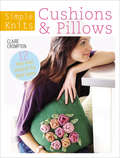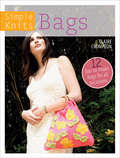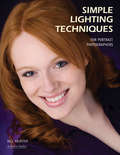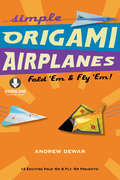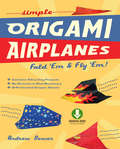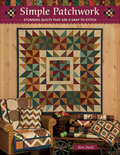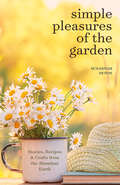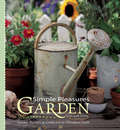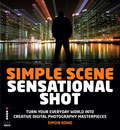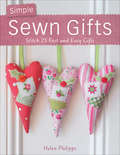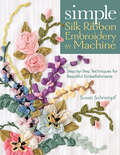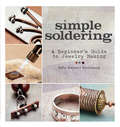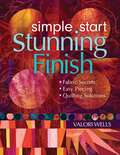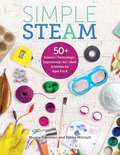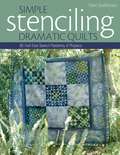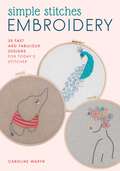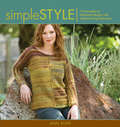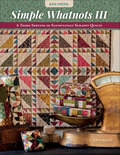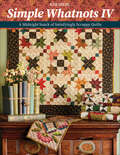- Table View
- List View
Simple Knits: 12 Easy-Knit Projects for Your Home (Simple Knits)
by Claire CromptonPatterns for the coziest and cutest cushions, seating cubes, and pillows from the established designer and bestselling author of The Knitter&’s Bible. Featuring strong designs across a range of styles for the new-to-knitting market, all the projects included are either Beginner, Easy or Intermediate skill level, and the majority are Easy. As well as patterns and project instructions, you will also find an explanation of the abbreviations used, a knitting needle conversion chart, a skill level key, a standard yarn weight chart, knitting techniques and making-up techniques. Projects include: · Pompom Cushion · Bright Stripe Pillows · Beaded Cushions · Black and White Pillow · Vibrant Seating Cube · Fringed Ribbon Pillow · French Knitted Cushions · Blooming Rose Pillow · Diamond Pattern Pillow · Bunting Cushion
Simple Knits: 12 Fun-to-Make Bags for All Occasions (Simple Knits)
by Claire CromptonStitch up fashionable and fabulous bags with patterns from the established designer and bestselling author of The Knitter&’s Bible. Featuring strong designs across a range of styles for the new-to-knitting market, all the projects included are either Beginner, Easy or Intermediate skill level, and the majority are Easy. As well as patterns and project instructions, you will also find an explanation of the abbreviations used, a knitting needle conversion chart, a skill level key, a standard yarn weight chart, knitting techniques and making-up techniques. Projects include: · Fake Fur Handbag · Drawstring Bag · Patchwork Shoulder Bag · Chunky Button Backpack · The Convertible Bag · Cow-Print Shopping Tote · Summer Flower Bag · Frilly Handbag · Simple Shoulder Bag · Posy Purse · Bead Trim Evening Bag · Rose Corsage Pinstripe
Simple Lighting Techniques for Portrait Photographers
by Bill HurterWith tips for creating natural, hassle-free lighting, this reference shows photographers how to abandon complex lighting scenarios in favor of more straightforward, uncomplicated ones. Photographers will learn the advantages of simpler lighting-such as saving money by avoiding excessive equipment purchases and maintenance and making location shoots less cumbersome and more convenient. Emphasizing that photographers should imitate the sun's natural light-not only to create a realistic setting but also to allow for genuine facial expressions from more relaxed portrait subjects-this guidebook illustrates how to create one- and two-light setups, making simple refinements with lightweight, inexpensive, and portable reflectors. Covering the basics of lighting and applying them to
Simple Origami Airplanes
by Andrew DewarFold and fly your own realistic paper airplanes with this easy origami book.Simple Origami Airplanes presents a collection of realistic origami paper airplanes from well-known author and paper aviation expert Andrew Dewar. Dewar has spent decades perfecting the art of folding easy paper airplanes that both look great and fly well. Simple Origami Airplanes features models with sturdy wings and fuselages-these designs are so perfectly balanced that a gentle throw results in amazing flights, time after time.All the origami projects are designed to be simple enough to be considered "origami-for-kids" projects, and can be assembled by beginning origami folders. Paper airplanes are a great way for children to learn origami and gain an interest and appreciation for this fascinating art form.This origami book contains: Full-colored origami assembly book Step-by-step instructions and diagrams 16 original design projects for planesFun and accessible for both the paper crafts novice and the more season paper folder, this wonderfully giftable origami book gets you started right away and is a great value.Origami airplane projects include: Flying Wing Beta Jet Kraken Interceptor Shark's Tooth And many more...
Simple Origami Airplanes
by Andrew DewarFold and fly your own realistic paper airplanes with this easy origami kit. Simple Origami Airplanes Mini Kit presents a collection of realistic origami paper airplanes from well-known author and paper aviation expert Andrew Dewar. Dewar has spent decades perfecting the art of folding easy paper airplanes that both look great and fly well. Simple Origami Airplanes Mini Kit features models with sturdy wings and fuselages—these designs are so perfectly balanced that a gentle throw results in amazing flights, time after time. All the origami projects are designed to be simple enough to be considered "origami-for-kids" kits, and can be assembled by beginning origami folders. Paper airplanes are a great way for children to learn origami and gain an interest and appreciation for this fascinating art form. The flashy folding papers already have plane images printed on them, making the finished origami planes look as awesome as they fly. As an added bonus, the accompanying DVD shows precise instructions and tips from the designer. This origami kit contains: Full-colored 32-page booklet Step-by-step instructions and diagrams 6 original design projects for planes 24 origami folding papers A variety of colors with printed fold lines A DVD with easy-to-follow video tutorials Fun and accessible for both the paper crafts novice and the more season paper folder, this wonderfully giftable origami kit gets you started right away and is a great value. The pre-colored origami paper is ready to fold—No scissors or glue required! Origami airplane projects include: The Razor The Octopus The Starbird The Swordfish The Frankenplane The Orbit
Simple Patchwork: Stunning Quilts That Are a Snap to Stitch
by Kim DiehlJam-packed with Kim’s tried-and-true tips Quilters everywhere have fallen in love with Kim Diehl's beautiful quilts, and you can too! In this latest collection, Kim focuses exclusively on patchwork for those who love her style but don't have the time or inclination to add appliqué touches. Make your way through sixteen easy-to-piece projects from wall quilts, table toppers, bed quilts with supersized blocks, and even a charming mini sampler quilt, all in Kim's sought-after style. Best-selling author Kim Diehl of the popular Simple series returns with dozens of tried-and-true tips—no matter the skill level, they'll make every quilter a better quilter. Play with simple Snowball and Churn Dash blocks or try showy stars and zigzags. Browse through spectacular photography throughout the book, offering a wealth of display ideas.
Simple Pictures Are Best
by Nancy WillardA shoemaker and his wife being photographed for their wedding anniversary keep adding items to the picture despite the photographer's admonition that "Simple pictures are best."
Simple Pleasures of the Garden: Stories, Recipes & Crafts from the Abundant Earth (Simple Pleasures Ser.)
by Susannah SetonSimple Pleasures Throughout the Year “Simple Pleasures has become my go-to book for remembering to slow down and enjoy the little things in life.” —Becca Anderson, bestselling author of Badass Affirmations, The Book of Awesome Women, and moreAn abundant sourcebook of ideas, encouraging quotes, recipes, and soothing activitiesSimple Pleasures of the Garden shows you how to appreciate the simple things within your daily activities. The secret to living well year round can be found in the abundance of your home garden, so get to planting those seeds of simple joys and herbal healing! Nurture your mind, body, and soul. Sometimes finding the positive can be hard, but it doesn’t have to be. From the recipe for a homemade herbal bath for a spa day to quick and easy recommendations for an instant room makeover, the suggestions and home recipes collected in this book offer a new appreciation for the everyday activities that nurture and comfort you.Simplify your emotional self care. Taking care of yourself doesn’t have to be expensive, unrealistic, or inaccessible. It can be as easy as tending to a green garden, making healing herbal tonics, sipping calming teas, or spending time with other natural energy boosters. Pleasures are made, not bought, so unlock new secrets to happiness with these touching stories, practical tips, and satisfying crafts. Inside this positive attitude book you’ll find: Ways to decorate your home with nature crafts, growing herbs, and an air of magic Advice on how to foster a routine for a rejuvenating self care yearTips on how to become the gardener of your moods and emotionsIf you liked seasonal self care books like A Year of Self-Care, Grow Your Own Medicine, or A Woman’s Garden, you’ll love Simple Pleasures of the Garden.
Simple Pleasures of the Garden: Stories, Recipes & Crafts from the Abundant Earth (Simple Pleasures Series)
by Susannah SetonA collection of gardening tips, recipes, crafts, gift ideas, tales, and more from the author of Every Garden Is a Story.Simple Pleasures of the Garden is a treasure chest of tips, how-to&’s, stories, and trade secrets gathered together in one beautiful book. Organized by season, the hundreds of suggestions and recipes present a profusion of ways to celebrate the bounty of the Earth all year round. Projects include handcrafted lotions and oils, baskets and wreaths, potpourris and floral waters, along with dozens of simple, inexpensive home decorations and easy-to-prepare recipes that utilize all of your garden&’s harvest. From compost tea to confetti corn chowder, Simple Pleasures of the Garden will inspire you to bestow the comforts and charms of your garden on family and friends.
Simple Pleasures of the Home: Comforts and Crafts for Living Well (Simple Pleasures Series)
by Susannah SetonA room-by-room guide to creating domestic bliss.Home—it’s the place where we can let down our hair, loosen our clothes, put our feet up. It’s where those we love most share in the ordinariness and extraordinariness of our days. It’s where many of us spend lifetimes trying to get back to. As the proverb goes, it’s where our hearts are.Simple Pleasures of the Home is for everyone who has the nesting impulse—from passionate and accomplished home decorators to anyone who simply enjoys domestic downtime. Organized room by room, the book includes dozens of:Simple activities for bringing the family togetherCreative ideas for pampering yourself and loved onesEasy-to-follow instructions for making aromatherapy productsTips for candlemakingComfort-food recipes, and more
Simple Pleasures of the Kitchen: Recipes, Crafts & Comforts from the Heart of the Home
by Susannah SetonA collection of recipes, crafts, and activities to bring your family together in the kitchen, from the author of Simple Pleasures of the Garden. The kitchen really is the heart of the home. It&’s the first place family and friends gather, not only to prepare and eat food, but to chat, sip tea, snack on home-baked cookies, unwind after a tough day, and reconnect with loved ones. The latest in the Simple Pleasures series of books, Simple Pleasures of the Kitchen captures the essence of the kitchen. It offers a cornucopia of recipes, food-based crafts, food facts and tips, and family activities, as well as stories from kitchens around the world sure to warm anyone&’s heart, no matter what the weather. Organized by season, the book offers: Spring Flings, The Savor of Summer, Autumn&’s Abundance, and Cozying Up in Winter. Recipes include comforting mashed potatoes, fresh summer risotto, delicious meatloaf, and heart-warming brownies and popovers. The super-simple jam recipe will go great with popovers, or as a gift in jars you&’ve decorated yourself. You can satisfy your sweet tooth and your soul at the same time! Susannah Seton&’s Simple Pleasures books continually delight readers with their down-home recipes, crafts, and activities that bring the whole family together. Don&’t miss this one.&“This enchanting and entertaining book reminds us of the importance of these times, how the simplest of events and day-to-day activities all blend to create cherished memories.&”—Jonathon King, cofounder of Stonewall Kitchen, from the Introduction
Simple Sashiko: 8 Sashiko Sewing Projects for the Modern Home
by Susan BriscoeLearn the big stitch technique of Sashiko with these 8 simple sashiko sewing projects. Big stitches are used to create stunning, geometric patterns and texture. This collection includes 8 home decor patterns including coasters, cushions, wall hangings, bag and greetings cards. Features content previously published in The Ultimate Sashiko Sourcebook and Japanese Sashiko Inspirations.
Simple Scene Sensational Shot: Artistic Photography In Any Environment
by Simon BondTurn your everyday world into creative digital photography masterpieces. This book shows how to make the most of your local area to create outstanding photos that will have your friends gasping and exclaiming, 'is this really our town?'
Simple Scene Sensational Shot: Artistic Photography in Any Environment
by Simon BondHow many of us have put our camera away after a holiday to a far-off location? This book will show you how to make the most of your local area to get outstanding photos that make people ask, 'Is this really our town?'Full of technical advice, it teaches a whole host of transformative techniques to let you discover - and make the most of - the potentially great imagery that surrounds you in any environment. Also learn how to use creative composition to capture a whole range of different shots from one location with a dedicated case-study section. From texture-rich abstracts to cleanly composed streetscapes, Simple Scene Sensational Shot shows you the great photography right outside your door.
Simple Sewn Gifts: Stitch 25 Fast and Easy Gifts
by Helen PhillipsIndulge your creativity—and stitch twenty-five fast and easy gifts from the heart. A unique laundry bag, a retro apron, a Christmas stocking . . . Every one of these gorgeous gift ideas is simple to make, leaving you free to get creative with the embellishments. Yo-yos, appliqué, embroidery, and other stitching techniques add that essential touch of personalization and care to every project. Best of all, they also provide the perfect opportunity for you to try your hand at new decorative tricks—on a small and easy scale. Includes color photos.
Simple Silk Ribbon Embroidery by Machine: Step-by-Step Techniques for Beautiful Embellishments
by Susan SchrempfUse Any Sewing Machine to Create Embroidered Embellishments. Create intricate silk ribbon embroidery that looks hand-stitched-without the slow hand work. Easy techniques really work with any sewing machine. Classroom-tested lessons specifically designed for beginners include step-by-step how-to photos and ribbon recommendations. Inspiring gallery shows the stitches combined in stunning finished pieces. Do you love the look of silk ribbon embroidery, but not the tedious handwork? Now you can create beautiful embroidery entirely by machine. Susan Schrempf shows you how to create stems, leaves, flowers, roses and rosebuds, loops, French knots, and ruching. Her student-tested techniques make it all so easy!
Simple Soldering: A Beginner's Guide to Jewelry Making
by Kate RichbourgMetalworking is generally regarded as a skill that takes years of dedication, requires a large studio space, and costs a lot of money. Fortunately, Simple Soldering proves that does not need to be the case. This handy how-to guide is complete in its exploration of the craft of creating soldered metal jewelry, including tools, techniques, and 20 beautiful projects that beginners and enthusiasts can make at home.Author and teacher Kate Richbourg demystifies basic soldering for any home crafter, showing how to create sophisticated, polished, and professional-looking jewelry pieces through simple soldering techniques. First, she instructs how to set up a jewelry workspace that fits the confines of your budget and living space. Detailed step-by-step instructions walk you through the basic tools and materials you need, plus how to use them. A sample chapter gives a host of introductory exercises that teach solid skills, allowing you to test these techniques on a small scale. Finally, you'll discover 20 finished projects that include earrings, pendants, rings, bracelets, and clasps that may also include bead or wire embellishment.Kate also demonstrates how to combine and layer techniques to gorgeous effect. She also examines common mistakes, shows how to correct or adapt them, and gives advice on when it's time to start over. Most of all, having taught thousands of classes on soldering, Kate has a "you can do it!" attitude that shines through to help even the most reluctant jewelry maker fire up the torch with ease.With Simple Soldering, the art of metal working one-of-a-kind jewelry is now at your fingertips.
Simple Start, Stunning Finish
by Valori WellsTurn Circles, Squares and Rectangles into Gorgeous Quilts • 15 hip, quick-to-make quilts that get dramatic results from simple shapes and large-scale prints • Color inspirations from traditional to trendy, soft to spicy • Sizes that suit your décor, from smaller wallhangings to large bed-sized quilts • Learn Valori's secrets of successful quiltmaking - color and fabric selection, design, piecing and appliqué techniques, and more Valori shows you how to make striking, colorful quilts that only look hard to make - use her techniques to get beautiful results in a lot less time than you'd think! Project instructions include tips on choosing fabrics, working with color, strip piecing to create amazing color effects, appliqué, curved and paper piecing, and easy ways to quilt the finished top. Time-challenged quilters and beginners looking to build their skills will love this fresh approach.
Simple Steam: 50+ Science Technology Engineering Art and Math Activities for Ages 3 to 6
by Debby Mitchell Marnie ForestieriParents are eager to help their children learn, but teaching young children complicated scientific and mathematical concepts can be intimidating. Simple STEAM helps parents realize they don't need to be engineers or scientists to support STEAM learning. <P><P> <li>Help children explore STEAM concepts with fun and engaging activities <li>Discover STEAM learning opportunities in everyday activities and experiences <li>Prepare children for kindergarten <li>Build crucial 21st century learning skills, such as collaboration, communication, creativity and problem-solving, curiosity, and critical thinking
Simple Stenciling Dramatic Quilts: 85 Full-Size Stencil Patterns, 6 Projects
by Pam StallebrassBeautiful Effects From Simple Stencil Magic! • Choose from 85 full-sized stencil patterns or create your own and apply to simple pieced quilts • Turn bland fabrics into stunning, look-at-me originals • It’s easy, inexpensive, and fun for all ages! "Breathtaking," they'll murmur as they line up to compliment you on the intricate effects in your quilts. But look again—those designs are created using simple techniques and a little fabric paint! You can get the look of traditional appliqué, German papercutting, Hawaiian appliqué, sun printing from nature, and exotic printed fabrics. This simple method uses easy-to-find materials such as freezer paper, template material, and fabric paints, dyes, or crayons.
Simple Stitches Embroidery: 39 fast and fabulous designs for today's stitcher
by Caroline WarynAll you need to know to start embroidering and complete your first project fast!Simple Stitches Embroidery teaches the basics of embroidery, from materials and techniques to the most popular stitches. All stitches are illustrated and explained, and patterns and instructions are included for 39 embroidered pieces in popular styles and colors. From adorable elephants for the nursery to cacti for the office and llamas for anywhere, the designs in this book are all easy enough for the beginner. Step-by-step instructions walk you through each project. Finish your pieces as wall hangings right in their hoop, or make small pins or embellishments.Whether you are a beginner or more experienced needleworker, the refreshing and delightful designs in this book are sure to bring many happy hours of stitching!
Simple Style: Innovative to Traditional 17 Inspired Designs to Knit (Style Ser.)
by Ann BuddFrom simple stripes to intricate Fair Isle patterns, this resource provides a solid foundation and numerous examples of the best ways to bring knits to life. Full of gorgeous patterns and clear instructions, 15 top knitwear designers - including Véronik Avery, Mags Kandis, Deborah Newton, Kristin Nicholas, and Shirley Paden - provide inspiration and practical projects for the beginning and experienced knitter alike. From an easy-to-knit pullover that alternates narrow stripes of solid and variegated yarns to a multicolored Fair Isle cardigan worked with steeks, this guidebook is filled with projects that take advantage of the countless ways in which knits can be enriched with color.
Simple Times
by Amy SedarisAmerica's most delightfully unconventional hostess and the bestselling author of I Like You delivers a new book that will forever change the world of crafting. According to Amy Sedaris, it's often been said that ugly people craft and attractive people have sex. In her new book, SIMPLE TIMES, she sets the record straight. Demonstrating that crafting is one of life's more pleasurable and constructive leisure activities, Sedaris shows that anyone with a couple of hours to kill and access to pipe cleaners can join the elite society of crafters. You will discover how to make popular crafts, such as: crab-claw roach clips, tinfoil balls, and crepe-paper moccasins, and learn how to: get inspired (Spend time at a Renaissance Fair; Buy fruit, let it get old, and seewhat shapes it turns into); remember which kind of glue to use with which material (Tacky with Furry, Gummy with Gritty, Paste with Prickly, and always Gloppy with Sandy); create your own craft room and avoid the most common crafting accidents (sawdust fires, feather asphyxia, pine cone lodged in throat); and cook your own edible crafts, from a Crafty Candle Salad to Sugar Skulls, and many more recipes. PLUS whole chapters full of more crafting ideas (Pompom Ringworms! Seashell Toilet Seat Covers!) that will inspire you to create your own hastily constructed obscure d'arts; and much, much more!
Simple Whatnots III: A Third Serving of Satisfyingly Scrappy Quilts
by Kim DiehlThe bestselling author and fabric designer shares instructions for 18 fun-to-complete, petite quilts packed with style! Bestselling author Kim Diehl is at it again with spectacular, small, and scrappy projects. In the third book of her Simple Whatnots series, Kim continues to delight you with helpful Extra Snippet tips, tried-and-true decorating ideas, plus the many perks of pint-size projects. The 18 delightful projects include traditionally pieced blocks as well as a sprinkling of Kim’s signature invisible machine appliqué and even a bit of wool appliqué. See how to maximize your scraps in triangle squares, flying geese, stars, and more to create stunning little quilts. Delve into your scrap basket and re-create Kim’s signature look to decorate your favorite little places around your home. Small quilts are quick to make and add interest to home decor. Dozens of photos offer inspiration for displaying finished quilts.
Simple Whatnots IV: A Midnight Snack of Satisfyingly Scrappy Quilts
by Kim DiehlCreate charming small quilts that will brighten up any space Best-selling author Kim Diehl presents the fourth and final installment of her Simple Whatnots series, unveiling a fresh collection of 19 small, scrappy projects. Kim continues to share her insightful Extra Snippet tips, decorating ideas, and the advantages of compact projects. The projects showcase Kim’s distinctive designs using invisible machine appliqué and wool appliqué techniques. Encouraging you to explore your scrap baskets, Kim continues to teach you how to use triangle squares, flying geese, stars, and more to create uniquely captivating small quilts for charming home decor. Best-selling author and fabric designer Kim Diehl shares instructions for 19 fun-to-complete quilts Create small yet charming quilts to enhance your home decor, with dozens of charming photographs offering inspiration and displaying ideas The fourth book in her best-selling Simple quilting series
